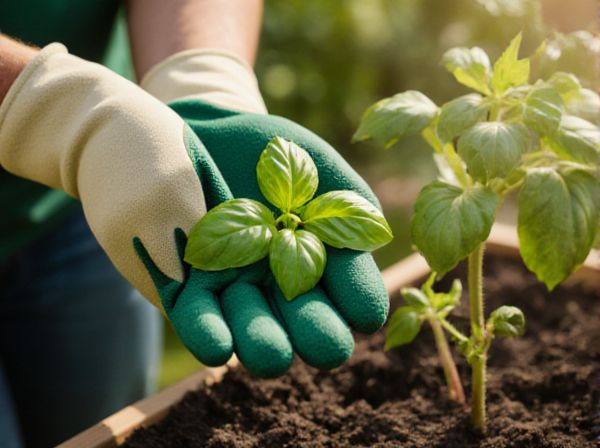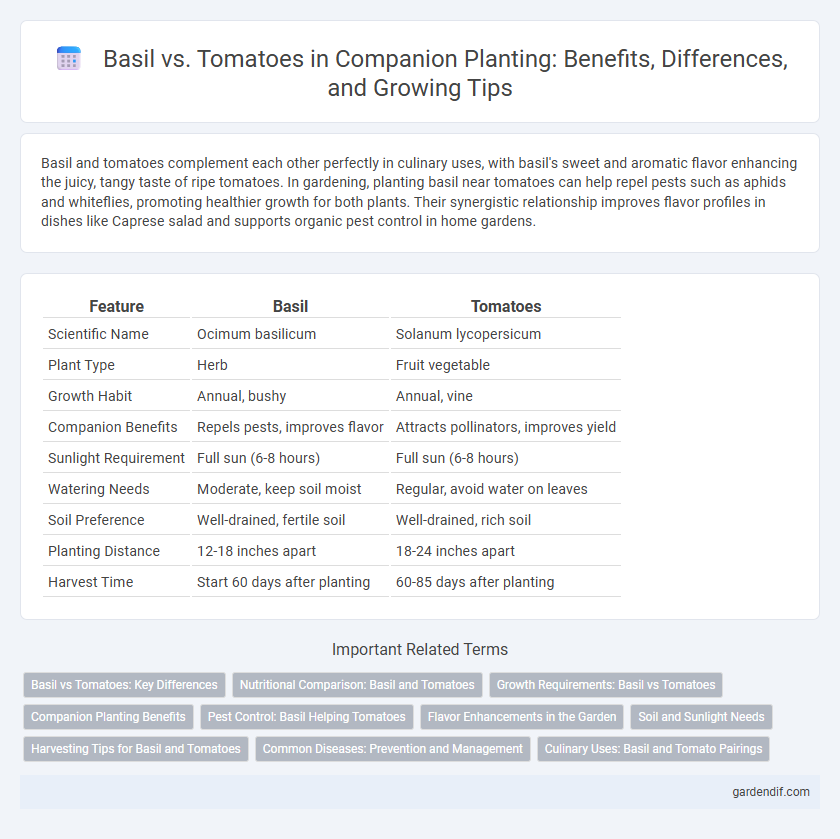
Basil vs tomatoes Illustration
Basil and tomatoes complement each other perfectly in culinary uses, with basil's sweet and aromatic flavor enhancing the juicy, tangy taste of ripe tomatoes. In gardening, planting basil near tomatoes can help repel pests such as aphids and whiteflies, promoting healthier growth for both plants. Their synergistic relationship improves flavor profiles in dishes like Caprese salad and supports organic pest control in home gardens.
Table of Comparison
| Feature | Basil | Tomatoes |
|---|---|---|
| Scientific Name | Ocimum basilicum | Solanum lycopersicum |
| Plant Type | Herb | Fruit vegetable |
| Growth Habit | Annual, bushy | Annual, vine |
| Companion Benefits | Repels pests, improves flavor | Attracts pollinators, improves yield |
| Sunlight Requirement | Full sun (6-8 hours) | Full sun (6-8 hours) |
| Watering Needs | Moderate, keep soil moist | Regular, avoid water on leaves |
| Soil Preference | Well-drained, fertile soil | Well-drained, rich soil |
| Planting Distance | 12-18 inches apart | 18-24 inches apart |
| Harvest Time | Start 60 days after planting | 60-85 days after planting |
Basil vs Tomatoes: Key Differences
Basil and tomatoes differ significantly in botanical classification, with basil being an aromatic herb from the Lamiaceae family and tomatoes a fruit from the Solanaceae family. Their growth requirements vary; basil thrives in warm, sunny conditions with well-drained soil, while tomatoes need more space and support for their vine-like growth. Nutritionally, basil offers essential oils rich in antioxidants and vitamins A and K, whereas tomatoes provide high levels of vitamin C, potassium, and lycopene, a potent antioxidant.
Nutritional Comparison: Basil and Tomatoes
Basil is rich in vitamin K, essential for blood clotting and bone health, while tomatoes provide abundant vitamin C, supporting immune function and skin health. Tomatoes offer a significant amount of lycopene, a powerful antioxidant linked to reduced risk of chronic diseases, whereas basil contains flavonoids that contribute to anti-inflammatory benefits. Both herbs and vegetables complement each other nutritionally, making their combination beneficial in a balanced diet.
Growth Requirements: Basil vs Tomatoes
Basil requires well-drained, nutrient-rich soil with consistent moisture and full sun exposure for optimal growth, thriving best in temperatures between 70-85degF. Tomatoes prefer slightly acidic soil with a pH of 6.0-6.8, require deep watering to develop strong root systems, and benefit from at least 6-8 hours of direct sunlight daily. Both plants demand warm conditions but tomatoes need more space for sprawling growth, while basil grows densely and benefits from regular pruning to encourage bushiness.
Companion Planting Benefits
Basil enhances tomato growth by repelling harmful pests such as aphids, whiteflies, and tomato hornworms, reducing the need for chemical pesticides. The aromatic oils in basil improve tomato flavor and increase yield, making it a valuable companion plant in vegetable gardens. Planting basil alongside tomatoes also promotes better air circulation and reduces disease risk, contributing to healthier and more productive plants.
Pest Control: Basil Helping Tomatoes
Basil acts as a natural pest repellent for tomatoes by deterring harmful insects such as aphids, whiteflies, and tomato hornworms, reducing the need for chemical pesticides. Its strong aromatic oils confuse and repel pests, protecting tomato plants from infestations that can decrease yield and plant health. Planting basil alongside tomatoes enhances pest control, promoting healthier and more productive tomato crops.
Flavor Enhancements in the Garden
Basil enhances tomatoes by releasing aromatic oils that intensify the fruit's natural sweetness and reduce bitterness, creating a more flavorful harvest. Planting basil near tomatoes can also deter pests like aphids and whiteflies, preserving the tomatoes' quality and taste. This symbiotic relationship results in richer, more robust tomato flavors directly from the garden.
Soil and Sunlight Needs
Basil thrives in well-drained, nutrient-rich soil with consistent moisture, requiring at least 6 hours of direct sunlight daily to grow robustly. Tomatoes prefer slightly acidic to neutral soil with good fertility and adequate organic matter, needing full sun exposure for 6 to 8 hours each day to produce healthy fruit. Ensuring proper soil conditions and ample sunlight maximizes the growth and yield when planting basil and tomatoes together.
Harvesting Tips for Basil and Tomatoes
Basil leaves should be harvested just before flowering to ensure peak flavor, using clean scissors to snip stems above a pair of leaves to encourage bushier growth. Tomatoes require harvesting when they reach full color and firmness appropriate to their variety, typically indicated by a deep, uniform hue and slight softness to the touch. Both herbs and vegetables benefit from morning harvests for optimal freshness and longevity.
Common Diseases: Prevention and Management
Basil and tomatoes are susceptible to common diseases such as powdery mildew, fusarium wilt, and blight, which can significantly impact plant health and yield. Implementing crop rotation, ensuring proper spacing for air circulation, and using resistant varieties effectively prevent disease spread in both plants. Timely application of organic fungicides and maintaining consistent moisture levels help manage infections and promote robust growth in basil and tomatoes.
Culinary Uses: Basil and Tomato Pairings
Basil and tomatoes create a classic culinary pairing, enhancing each other's flavors in dishes such as Caprese salad, pasta sauces, and bruschetta. The sweet, aromatic notes of basil complement the acidic, juicy profile of tomatoes, elevating the overall taste experience. This combination is essential in Mediterranean cuisine, offering a fresh and vibrant flavor balance.
Basil vs tomatoes Infographic

 gardendif.com
gardendif.com